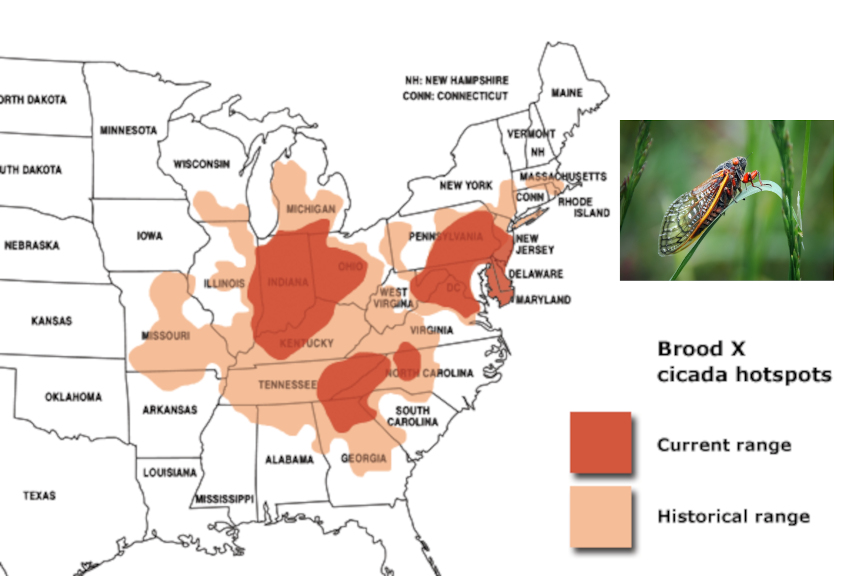For those of us in the eastern portion of the United States this May has once again brought the invasion of the 17-year cycle of the Brood X cicadas. For those who haven’t had the experience, once every 17 years, millions of bizarre-looking insects burrow their way up out of the ground. Climbing onto the trunks of trees, these underground dwelling nymphs wait on their perches until their exoskeletons harden enough for them to molt and turn into the even more bizarre-looking adult shown in the inset of the figure below.

But what follows puts the rest of the ‘science fiction’ story to shame. Once mature, the adult cicadas get to feeling a ‘little anxious’ and, in droves, begin a song of sex and attraction that has to be experienced to be truly believed. The sound these guys make is surreal and grows louder and louder each day as their mating reaches a crescendo. The constant hum is everywhere during most daylight hours and, depending on one’s mood and temperament can present a pleasant distraction to a maddening torment.
Despite their size (over an inch long) the adults can get everywhere: covering sidewalks, swamping mailboxes, and generally bumping into things. Dogs and cats love these things although it also seems to be literally a matter of taste as to whether any given pet will eat them versus playing with them.
Once the mating is done, the entire population up and dies leaving carcasses everywhere. Eventually, the experience winds down and, mercifully, one soon forgets that it ever happened. But while it is happening what a strange experience each day is.
Well, enough cicada strangeness, now onto the columns.
This month’s Aristotle2Digital continues the multi-part look at category theory, which while often strange-looking, can’t hold a candle to cicada strangeness. Nonetheless, the primary focus is on the so-called division problems within the category of sets. The specialized machinery that results, the retraction and section defined to automorphisms, provides a new way of expressing some old ideas about when a mapping has an inverse.
As if the common eastern seaboard motorist didn’t already have enough to deal with during the month of May with COVID and cicadas, he was then hit with the additional whammy of gasoline shortages and long lines due to the ransomware attack on the Colonial Pipeline. Although it turned a difficult month into something even more nerve-wracking, the economic fallout from this event was rich and varied. This month’s CommonCents touches on some of the big issues that will, no doubt, be the conversation of economists for years to come.
Despite the fact that the basic concept of entropy has been around for over a hundred years, a deep understanding of it remains elusive. Nothing drives this home as much as the Gibbs Paradox that arise from what is most tractable of all multi-body physical systems, the ideal gas. UndertheHood examines the basic structure of the Gibbs Paradox, the orthodox solution to the problem, and some ideas by a researcher who believes that there is something new in something old.
Enjoy!

